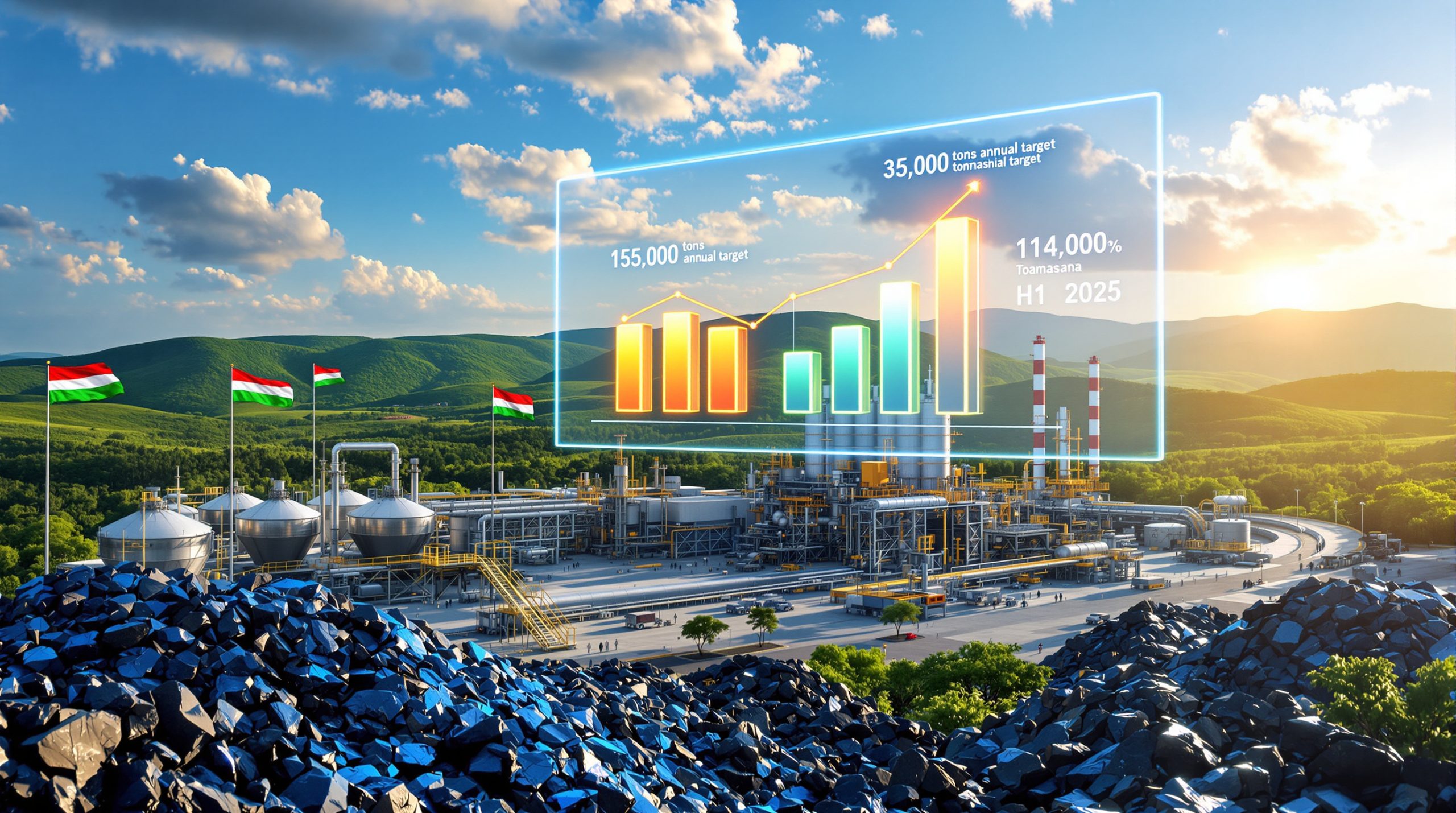Understanding Chile's Position in the Global Copper Cost Landscape
Chile maintains its status as the world's largest copper producer, accounting for approximately 24% of global output through major mining operations concentrated primarily in the northern Atacama Desert region. The country's copper mining costs in Chile have traditionally positioned it in a challenging competitive landscape, with production expenses generally falling within the third to fourth quartile when compared to other major copper-producing nations worldwide.
Recent data from the Chilean Copper Commission (Cochilco) reveals that 21 major mining operations, representing 94% of the country's copper production, continue to face cost pressures despite temporary improvements in the first half of 2025. These operations range from massive open-pit mines like Chuquicamata to underground facilities, each contributing to Chile's dominant position in global copper supply forecast.
The scale of Chilean operations provides both advantages and challenges for cost management. Large-scale mines benefit from economies of scale in equipment procurement, processing efficiency, and infrastructure utilisation. However, many of Chile's major copper deposits are mature mining districts with decades of extraction history, leading to increasingly complex operational requirements and higher per-unit production costs. Furthermore, the largest copper mines overview demonstrates the strategic importance of these facilities in global supply chains.
Key Components Driving Chilean Copper Production Expenses
Direct extraction costs represent the most significant component of copper mining costs in Chile, encompassing drilling, blasting, hauling, and primary processing activities. These operational expenses have increased substantially over recent years due to deeper mining requirements and lower ore grades requiring greater processing volumes to achieve equivalent copper recovery rates.
Energy consumption patterns significantly impact Chilean mining economics, despite the country's historical advantages in power generation costs. Copper mining operations are extremely energy-intensive, requiring substantial electricity for grinding, flotation, smelting, and refining processes. The transition toward renewable energy sources has provided some cost relief, though energy remains a major expense category for all Chilean producers.
Labour and equipment expenditures constitute another critical cost driver, with Chilean mining operations employing highly skilled workers commanding premium wages compared to other mining jurisdictions. Equipment costs have risen due to the specialised machinery required for deep mining operations and the need for more frequent maintenance cycles as mines mature and operating conditions become more challenging.
Transportation and logistics factors add complexity to Chilean copper mining costs, particularly given the remote locations of many operations in the Atacama Desert. Moving massive quantities of ore, concentrate, and finished copper products requires extensive infrastructure networks, including specialised railways, port facilities, and trucking operations designed to handle the extreme conditions of northern Chile.
Recent Cost Trajectory and Market Dynamics
The 2025 Cost Decline: Analyzing Temporary Market Relief
Chilean copper mining costs experienced a notable decline during the first half of 2025, with cash costs falling to $1.767 per pound compared to $1.912 per pound during the same period in 2024. This 7.6% reduction marked a reversal of the sustained upward cost trajectory that had characterised Chilean mining operations in recent years, providing temporary relief to producers facing increasing operational pressures.
The primary drivers of this cost reduction were external market factors rather than operational efficiency improvements. Treatment and refining charges declined significantly during the period, reducing the costs that mining companies pay to process their copper concentrates into finished metal. Additionally, precious metal by-product credits provided substantial cost offsets as gold prices increased 39% and silver prices rose 26% during the first half of 2025.
Copper prices themselves contributed to improved economics, with London Metal Exchange copper rising 15.4% during the first half of 2025. While commodity price increases don't directly reduce mining costs, they improve project economics and can provide additional revenue through by-product sales and improved concentrate terms.
However, industry analysis suggests this cost reduction represents temporary market-driven relief rather than sustainable operational improvements. The underlying structural challenges affecting Chilean copper mining operations, including declining ore grades, aging infrastructure, and increasing extraction complexity, remain unchanged and continue to exert upward pressure on long-term production costs. In addition, trade war impact on copper continues to influence market dynamics.
Historical Context and Underlying Cost Pressures
Chilean copper mining operations have experienced a fundamental transformation from their historically low-cost positions to current higher-cost profiles over the past two decades. This transition reflects the maturation of Chile's premier copper districts, where decades of extraction have necessitated deeper mining, more complex processing requirements, and increased infrastructure investment to maintain production levels.
The evolution toward higher costs has been gradual but persistent, driven by geological realities that are largely beyond operational control. As surface and near-surface ore bodies become depleted, Chilean mines have been forced to extract copper from progressively lower-grade deposits at greater depths, requiring proportionally more energy, equipment, and processing capacity to produce equivalent copper quantities.
All-in sustaining costs (AISC), which include capital expenditures necessary to maintain production levels, have reached levels exceeding $2.20 per pound at many Chilean operations by recent years. These comprehensive cost measures reflect the true economic burden of maintaining copper production in mature mining districts, including ongoing capital requirements for equipment replacement, infrastructure upgrades, and mine development activities.
Comparing current cost levels with historical benchmarks reveals the magnitude of this transformation. Chilean operations that once ranked among the world's lowest-cost producers now face competitive challenges from newer mining districts in Peru, the Democratic Republic of Congo, and other emerging copper-producing regions with higher ore grades and more favourable geological conditions. Furthermore, us tariffs and copper supply dynamics continue to influence competitive positioning.
Primary Cost Drivers and Operational Challenges
Infrastructure Aging and Capital Requirements
Chilean copper mining operations face substantial costs related to aging infrastructure and equipment replacement requirements. Many of the country's major mines have been operating for decades, resulting in processing plants, transportation systems, and extraction equipment that require increasingly frequent maintenance and eventual replacement at significant capital expense.
Legacy equipment replacement represents a major ongoing cost category, as mining companies must continuously invest in new machinery to maintain production efficiency and safety standards. The harsh operating conditions in Chile's desert mining regions accelerate equipment wear, requiring specialised maintenance protocols and shortened replacement cycles compared to mines in more temperate climates.
Infrastructure maintenance expenditures have grown substantially as mines mature and their supporting systems age. Power distribution networks, water management systems, tailings facilities, and transportation infrastructure all require ongoing investment to maintain operational reliability and regulatory compliance, adding to the overall cost burden of Chilean copper production.
Efficiency degradation represents an additional challenge, as older equipment and infrastructure typically operate at lower productivity levels than newer alternatives. This reduced efficiency translates directly into higher per-unit production costs, as mines must allocate more resources to achieve equivalent copper output levels compared to operations with more modern infrastructure.
Energy Costs and Market Dynamics
Despite Chile's historical advantages in energy generation, power costs remain a significant component of copper mining costs in Chile. The country's transition toward renewable energy sources has provided some cost relief, particularly as solar and wind installations have reduced dependence on imported fossil fuels for electricity generation.
Chilean mining operations have increasingly invested in renewable energy infrastructure, including dedicated solar installations and wind farms designed to power mining operations directly. These investments require substantial upfront capital but can provide long-term cost stability and reduced exposure to volatile fossil fuel markets.
Grid-tied operations benefit from Chile's evolving energy market, which has seen increasing renewable energy penetration reduce overall electricity costs during peak solar and wind generation periods. However, mining operations require consistent 24-hour power supply, necessitating energy storage solutions or backup generation capacity that adds complexity and cost to power procurement strategies.
Future energy cost projections suggest continued opportunities for cost reduction through renewable energy adoption, though the magnitude of potential savings varies significantly based on specific mine locations, power requirements, and infrastructure investment capabilities of individual operators.
Comparative Analysis of Chilean Mining Operations
Large-Scale Operation Performance Variations
Chilean copper mining operations demonstrate significant cost variations based on operational scale, deposit characteristics, and management approaches. State-owned operations, primarily through Codelco, often face different cost structures compared to private mining companies due to distinct capital allocation processes, labour arrangements, and strategic priorities.
Cochilco's comprehensive assessment of 21 major operations provides insights into performance variations across the Chilean mining sector. These operations collectively represent 94% of national copper production, encompassing both open-pit and underground mines with varying ore grades, processing requirements, and operational complexities.
Performance differences among major producers reflect numerous factors including deposit geology, mine design, processing technology, and operational efficiency initiatives. Some operations benefit from higher ore grades or more favourable metallurgical characteristics, while others must overcome challenges related to complex mineralogy or difficult operating conditions. Consequently, mining costs analysis reveals significant variation across the sector.
The scale advantages available to major Chilean producers include bulk purchasing power for consumables and equipment, shared infrastructure costs, and specialised technical expertise. However, these benefits must be balanced against the challenges of managing large, complex operations in remote locations with aging infrastructure and declining ore grades.
Net Production Cost Optimisation
Several Chilean mining operations have achieved notable success in optimising net production costs through by-product credit maximisation and processing efficiency improvements. These operations focus on extracting maximum value from precious metals and other by-products contained within copper ore bodies, effectively reducing net copper production costs.
By-product credit optimisation represents a critical component of cost management for Chilean producers, as many deposits contain significant quantities of gold, silver, and molybdenum alongside copper. Effective extraction and marketing of these by-products can substantially reduce net copper production costs, particularly during periods of favourable precious metal pricing.
Processing efficiency improvements have enabled some operations to reduce unit costs through enhanced recovery rates, improved throughput, and reduced energy consumption per unit of copper produced. These operational enhancements require ongoing investment in technology and process optimisation but can provide sustainable cost advantages over time.
Concentrate grade optimisation strategies focus on producing higher-quality copper concentrates that command premium pricing or reduced treatment charges from smelters. This approach requires precise control over flotation and processing parameters but can improve overall project economics through enhanced revenue realisation.
External Market Factors Affecting Production Economics
Commodity Price Correlations and Treatment Charges
External commodity market dynamics significantly influence Chilean copper mining costs through treatment and refining charge fluctuations and by-product pricing variations. The substantial improvement in copper mining costs in Chile during the first half of 2025 was primarily attributed to favourable movements in these external factors rather than operational efficiency gains.
Treatment and refining charges represent the fees that mining companies pay to smelters and refineries for processing copper concentrates into finished metal. These charges fluctuate based on global supply and demand dynamics for smelting capacity, with periods of tight smelting capacity resulting in higher charges that increase net production costs for mining companies.
The decline in treatment charges during early 2025 provided direct cost relief to Chilean producers, as lower processing fees effectively reduced the total cost of bringing copper to market. This improvement reflected global smelting market conditions rather than changes in Chilean mining operations themselves, highlighting the importance of external market factors in determining net production costs.
By-product credit optimisation became particularly valuable during the first half of 2025 as precious metal prices surged. Gold price increases of 39% and silver price gains of 26% substantially enhanced the value of precious metals recovered from copper ore processing, providing direct offsets to copper production costs through increased by-product revenues. Moreover, copper price predictions suggest continued volatility in market conditions.
Currency Exchange Rate Implications
Currency exchange rate fluctuations between the Chilean peso and US dollar create significant impacts on reported copper mining costs, as operations incur expenses in local currency while copper prices are denominated in US dollars. Peso strength relative to the dollar increases reported costs when converted to the industry-standard dollar-per-pound metrics used for international comparisons.
USD-denominated cost components, including imported equipment, spare parts, and energy inputs, are directly affected by exchange rate movements. When the Chilean peso weakens against the dollar, these imported cost elements become more expensive in local currency terms, increasing overall production expenses for mining operations.
Many Chilean mining companies employ currency hedging strategies to manage exchange rate exposure and provide greater cost predictability for operational planning. These hedging approaches can include forward contracts, options, and other financial instruments designed to reduce the impact of peso-dollar volatility on reported production costs.
Exchange rate effects can either amplify or offset other cost drivers depending on currency movement directions and timing. During periods of peso strength, Chilean mining costs appear higher in dollar terms even if local operational efficiency improves, while peso weakness can make operations appear more competitive internationally despite unchanged local performance.
Technological Innovation and Cost Reduction Opportunities
Automation and Digital Mining Implementation
Chilean copper mining operations are increasingly investing in automation technologies and digital mining solutions to address rising labour costs and improve operational efficiency. These technological implementations focus on reducing manual labour requirements while enhancing safety, productivity, and cost control across mining operations.
Autonomous equipment deployment has gained traction at several Chilean mines, with automated haul trucks, drilling equipment, and processing systems designed to operate with minimal human intervention. These systems can provide cost benefits through reduced labour requirements, improved equipment utilisation, and enhanced safety performance in hazardous mining environments.
Predictive maintenance systems utilise sensor networks and data analytics to optimise equipment maintenance schedules, reducing both maintenance costs and unplanned downtime. These systems can identify potential equipment failures before they occur, allowing for scheduled maintenance during planned production breaks rather than emergency repairs that disrupt operations.
Real-time optimisation platforms integrate data from multiple operational systems to provide continuous process optimisation recommendations. These digital solutions can improve recovery rates, reduce energy consumption, and optimise equipment performance across complex mining and processing operations.
Processing Efficiency and Recovery Improvements
Advanced processing technologies offer opportunities for Chilean mines to reduce unit costs through improved copper recovery rates and reduced energy consumption per unit of production. These technological improvements are particularly valuable for operations processing lower-grade ores that require efficient extraction methods to maintain economic viability.
Enhanced flotation technologies focus on improving copper recovery from increasingly complex ore bodies while reducing the consumption of reagents and energy required for separation processes. These improvements can increase overall copper production from existing ore processing volumes, effectively reducing per-unit costs.
Processing optimisation strategies include real-time monitoring and control systems that automatically adjust operating parameters to maintain optimal recovery rates and minimise energy consumption. These systems can provide immediate response to variations in ore characteristics or processing conditions that might otherwise reduce efficiency.
Integration of artificial intelligence and machine learning technologies enables processing facilities to continuously optimise performance based on historical data and real-time operating conditions. These systems can identify optimal operating parameters that maximise recovery while minimising costs, providing ongoing efficiency improvements over time.
Future Cost Projections and Market Outlook
Short-Term Cost Expectations and Market Dynamics
Industry analysts project that copper prices will likely stabilise within a range of $10,000 to $11,000 per tonne through 2026 and 2027, reflecting expectations of market surplus conditions that could pressure pricing. These market dynamics will significantly influence the economic performance of Chilean copper mining operations, as commodity price movements directly affect project profitability and cost competitiveness.
Expected cost range stability for Chilean operations suggests that the temporary cost reduction experienced during the first half of 2025 may not be sustainable over longer time periods. As treatment charges return to historical levels and precious metal prices normalise, Chilean producers may face renewed upward pressure on production costs.
Market surplus implications could create additional challenges for higher-cost Chilean producers, as periods of excess copper supply typically result in pricing pressure that reduces margins for all producers. In such environments, operations with higher production costs face greater financial stress and may need to implement additional cost reduction measures to maintain viability.
Operational optimisation potential remains significant for Chilean mines, with opportunities to improve efficiency through technology adoption, process improvements, and infrastructure upgrades. However, realising these benefits requires substantial investment and may not be sufficient to offset underlying geological challenges affecting long-term cost trends.
Long-Term Structural Challenges and Investment Requirements
Chilean copper mining faces persistent long-term structural challenges that will likely continue exerting upward pressure on production costs regardless of short-term market improvements. These fundamental issues include continued ore grade decline, aging infrastructure replacement requirements, and increasing complexity of extraction operations.
Ore grade decline represents perhaps the most significant long-term cost driver, as Chilean mines extract copper from progressively lower-grade deposits over time. This geological reality requires proportionally greater processing volumes to maintain copper production levels, directly increasing energy consumption, equipment requirements, and operational complexity.
Infrastructure replacement requirements will demand substantial capital investment over the coming decade as Chile's mature mining operations require upgraded processing facilities, transportation systems, and support infrastructure. These capital expenditures are necessary to maintain production levels but add to the overall cost burden of Chilean copper operations.
Labour market dynamics may continue pressuring costs upward as skilled mining professionals command premium wages and Chile's remote mining locations require additional compensation to attract and retain qualified workers. Competition for technical expertise across the global mining industry may further intensify these labour cost pressures.
Investment Priorities and Strategic Responses
Capital expenditure requirements for maintaining cost competitiveness will likely focus on technology adoption, processing efficiency improvements, and infrastructure modernisation. Chilean mining companies must balance these investment needs against shareholder returns and debt service obligations while operating in an increasingly competitive global market.
Technology adoption represents a critical investment priority, with potential returns through improved productivity, reduced labour requirements, and enhanced operational efficiency. However, technology implementation requires substantial upfront capital and ongoing maintenance costs that must be carefully evaluated against expected benefits.
Exploration and resource development investments may provide opportunities to access higher-grade ore bodies or extend mine lives, potentially improving long-term cost profiles. However, exploration success is uncertain, and development of new resources requires years of lead time before providing operational benefits.
Strategic partnerships and industry consolidation may offer opportunities for cost sharing and operational efficiency improvements through economies of scale. Shared infrastructure projects, joint venture arrangements, and regional cooperation initiatives could help individual operators manage rising costs more effectively.
Strategic Cost Optimisation Approaches
Operational Excellence and Efficiency Programs
Chilean mining companies are implementing comprehensive operational excellence strategies designed to maximise efficiency and minimise waste across all aspects of their operations. These programs typically focus on lean mining methodologies that eliminate non-value-adding activities while optimising resource utilisation throughout the mining and processing value chain.
Supply chain optimisation initiatives target procurement costs, inventory management, and logistics efficiency to reduce overall operational expenses. These efforts often involve strategic supplier relationships, bulk purchasing agreements, and improved inventory turnover rates that can provide meaningful cost reductions without compromising operational performance.
Maintenance scheduling improvements utilise predictive analytics and equipment condition monitoring to optimise maintenance timing and reduce both planned and unplanned maintenance costs. Effective maintenance programs can extend equipment life, improve reliability, and reduce the total cost of ownership for major mining equipment.
Energy management programs focus on reducing power consumption through operational modifications, equipment upgrades, and improved process control. Given the energy-intensive nature of copper mining and processing, even modest efficiency improvements can translate into significant cost savings over time.
Regional Cooperation and Infrastructure Sharing
Shared infrastructure opportunities among Chilean mining operations provide potential cost reduction benefits through economies of scale and reduced capital requirements for individual operators. These collaborative approaches are particularly valuable for transportation, power generation, and processing facilities that can serve multiple mining operations efficiently.
Joint venture cost-sharing models enable mining companies to distribute the financial burden of major infrastructure investments while accessing capabilities that might be prohibitively expensive for individual operators. These arrangements are especially beneficial for smaller producers that can access world-class infrastructure without bearing full development costs.
Regional cooperation initiatives may include shared power generation facilities, common transportation corridors, and coordinated water management systems that provide cost advantages to participating operators. Such cooperation requires careful coordination and contractual arrangements but can provide substantial economic benefits to all participants.
Consolidated services arrangements allow multiple mining operations to share specialised services, technical expertise, and support functions that individual operations might not be able to justify economically. These shared service models can provide access to world-class capabilities while distributing costs across multiple operations.
Frequently Asked Questions About Chilean Copper Production Economics
Why Do Chilean Operations Face Higher Costs Than Emerging Producers?
Chilean copper mining costs reflect the mature nature of the country's mining districts, where decades of extraction have resulted in declining ore grades and increasingly complex operational requirements. Unlike newer mining regions with higher-grade deposits and less challenging extraction conditions, Chilean operations must process larger volumes of ore to produce equivalent copper quantities.
Higher labour and regulatory compliance costs also contribute to Chile's cost position, as the country maintains more stringent environmental and safety standards compared to some competing jurisdictions. While these standards provide important worker and environmental protections, they add to operational complexity and expense.
Infrastructure age and maintenance requirements represent additional cost factors, as Chile's established mining operations rely on processing plants, transportation systems, and support infrastructure that require ongoing investment to maintain functionality and efficiency.
What Role Does Chile Play in Global Copper Supply Security?
Chile's 24% share of global copper production makes it a critical component of international copper supply chains, with the country's mining performance directly affecting global copper availability and pricing. This dominant position provides Chile with significant influence over global copper markets, but also creates responsibility for maintaining reliable production levels.
Production volume trends and capacity constraints in Chilean operations can have immediate impacts on global copper pricing and availability. Supply disruptions from Chilean operations, whether due to operational issues, labour disputes, or regulatory changes, typically result in immediate copper price reactions on international markets.
Strategic importance to global supply chains makes Chilean copper operations essential infrastructure for industries dependent on copper supply, including electrical equipment manufacturing, construction, and renewable energy development. This strategic position provides both opportunities and challenges for Chilean producers in managing their cost competitiveness while fulfilling global supply responsibilities.
How Do Treatment and Refining Charges Affect Net Copper Costs?
Treatment and refining charge negotiations significantly impact the net costs that Chilean mining companies realise from their copper production. These charges represent the fees paid to smelters and refineries for processing copper concentrates into finished metal, with higher charges directly reducing net revenue for mining operations.
TC/RC levels fluctuate based on global supply and demand dynamics for smelting and refining capacity. During periods when smelting capacity is tight relative to concentrate supply, treatment charges tend to increase, effectively raising net production costs for mining companies. Conversely, when smelting capacity exceeds concentrate supply, treatment charges decline and improve mining company economics.
Regional processing capacity considerations influence the treatment charges available to Chilean producers, as concentrate transportation costs and smelter accessibility affect negotiating positions. Chilean producers benefit from proximity to domestic smelting capacity but must also compete in global markets for processing services.
The temporary cost reduction in Chilean copper mining during early 2025 demonstrates how external market factors can provide significant relief to production economics, though underlying structural challenges including declining ore grades and aging infrastructure continue to pressure long-term competitiveness in global markets.
Disclaimer: This analysis is based on available industry data and market observations. Future cost projections and market conditions involve inherent uncertainties and should not be considered as definitive forecasts. Copper mining investments involve substantial risks and potential investors should conduct thorough due diligence and consult with qualified financial advisors before making investment decisions.
Want to Capitalise on Copper Market Movements?
Discovery Alert's proprietary Discovery IQ model delivers instant notifications on significant ASX mineral discoveries, including copper exploration breakthroughs that could reshape market dynamics. With major copper producers facing persistent cost pressures like those in Chile, early identification of new, potentially lower-cost discoveries becomes crucial for informed investment decisions—begin your 30-day free trial today to position yourself ahead of market developments.




